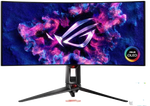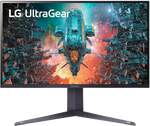A comparison of specs, key information, reviews, and best pricing from top retailers
Last updated -- hours ago | Report incorrect information
What we think

The PerfectRec monitor team Learn more
Updated April 11, 2024·
If you're seeking an immersive ultra-wide gaming experience with deep blacks and high contrast, the Asus W-OLED could be a great fit, though it's not ideal for high-resolution productivity tasks. Conversely, the LG IPS offers a sharper and brighter screen suitable for a variety of uses, including productivity and media consumption, but it lacks the infinite contrast of OLED and may not be as compelling for dark room gaming. If high refresh rate gaming with minimal ghosting is a priority, the Asus edges out, but if you value higher pixel density for detailed tasks and vibrant color for photo editing, the LG is a strong contender. Give Feedback
this description is based on the product variant with some specs and product variant with some specs. At the time of writing, the variant with some specs cost some dollars and the variant with some specs cost some dollars.
Advantages of the Asus PG34WCDM (W-OLED)
- Best in class for casual gaming
- Good for media consumption
- Very good refresh rate
- Best in class contrast
- Best in class response time
Advantages of the LG 32GQ950 (IPS)
- Very good for productivity
- Good text clarity
Key differences
Casual Gaming
9.5


6.2
3440 x 1440
RESOLUTION
3840 x 2160
240Hz
REFRESH RATE
160Hz
Inf:1
NATIVE CONTRAST
921:1
238 nits
SDR PEAK BRIGHTNESS
367 nits
716 nits
HDR PEAK BRIGHTNESS
1007 nits
96.6 %
DCI-P3 COLOR GAMUT
94.6 %
Matte
COATING
Semi-Gloss
The Asus PG34WCDM (W-OLED) is best in class for casual gaming, while the LG 32GQ950 (IPS) is only fair.
Competitive Gaming
5.6


4.7
240Hz
REFRESH RATE
160Hz
1.1 ms
TOTAL RESPONSE TIME
5.8 ms
20 - 240 Hz
VARIABLE REFRESH RATE
20 - 160 Hz
Yes
STROBING / BFI
No
238 nits
SDR PEAK BRIGHTNESS
367 nits
The Asus PG34WCDM (W-OLED) and LG 32GQ950 (IPS) are both poor for competitive gaming, though the Asus PG34WCDM (W-OLED) is somewhat better.
Productivity
5.7


8.1
3440 x 1440
RESOLUTION
3840 x 2160
109 PPI
PIXELS PER INCH
139 PPI
Yes
ADJUSTABLE STAND
Yes
Matte
COATING
Semi-Gloss
The LG 32GQ950 (IPS) is very good for productivity, while the Asus PG34WCDM (W-OLED) is poor.
Media Consumption
7.5


6.6
3440 x 1440
RESOLUTION
3840 x 2160
Inf:1
NATIVE CONTRAST
921:1
238 nits
SDR PEAK BRIGHTNESS
367 nits
716 nits
HDR PEAK BRIGHTNESS
1007 nits
Matte
COATING
Semi-Gloss
The Asus PG34WCDM (W-OLED) is good for media consumption, while the LG 32GQ950 (IPS) is only fair.
Cost
$1,300


$930
$0
$500
$1,000
$1,500
$2,000
The Asus PG34WCDM (W-OLED) has a price of $1,300 and the LG 32GQ950 (IPS) costs $930.
HDR Gaming and Media Consumption
Yes


No
The Asus PG34WCDM (W-OLED) is suitable for HDR gaming and media consumption while the LG 32GQ950 (IPS) is not suitable for HDR gaming and media consumption.
Key similarities
Digital Photo Editing
Yes


Yes
Both the Asus PG34WCDM (W-OLED) and LG 32GQ950 (IPS) are suitable for digital photo editing.
HDR Video Editing and Color Grading
No


No
Both the Asus PG34WCDM (W-OLED) and LG 32GQ950 (IPS) are not suitable for HDR video editing and color grading.
Print Photo Editing
No


No
Both the Asus PG34WCDM (W-OLED) and LG 32GQ950 (IPS) are not suitable for print photo editing.
Give feedback
We’re constantly working to improve.
How the Asus PG34WCDM (W-OLED) and the LG 32GQ950 (IPS) compare to other monitors
Spec Comparison
| Asus PG34WCDM (W-OLED) | LG 32GQ950 (IPS) |
GENERAL | |||
|---|---|---|---|
| Price | |||
$1,300 | $930 | ||
Screen Size | |||
Screen Size | 34" | 32" | |
Resolution | |||
Resolution | 3440 x 1440 | 3840 x 2160 | |
Screen Type | |||
Screen Type | OLED | LED | |
Screen Sub-type | |||
Screen Sub-type | W-OLED | IPS | |
Local Dimming Zones | |||
Local Dimming Zones | N/A | 32 | |
COLOR, CONTRAST & BRIGHTNESS | |||
|---|---|---|---|
Native Contrast | |||
Native Contrast | Inf:1 | 921:1 | |
SDR Peak Brightness | |||
SDR Peak Brightness | 238 nits | 367 nits | |
HDR Peak Brightness | |||
HDR Peak Brightness | 716 nits | 1007 nits | |
Suitable for HDR Gaming and Media Consumption | |||
Suitable for HDR Gaming and Media Consumption | Yes | No | |
sRGB Color Gamut | |||
sRGB Color Gamut | 100 % | 99.5 % | |
MOTION CHARACTERISTICS | |||
|---|---|---|---|
Total Response Time | |||
Total Response Time | 1.1 ms | 5.8 ms | |
Variable Refresh Rate | |||
Variable Refresh Rate | 20 - 240 Hz | 20 - 160 Hz | |
Strobing / BFI | |||
Strobing / BFI | Yes | No | |
Persistence Blur Score | |||
Persistence Blur Score | 8/10 | 7/10 | |
Ghosting Score | |||
Ghosting Score | 9.6/10 | 8.1/10 | |
TEXT & IMAGE CLARITY | |||
|---|---|---|---|
Pixels Per Inch | |||
Pixels Per Inch | 109 PPI | 139 PPI | |
Coating | |||
Coating | Matte | Semi-Gloss | |
Text Clarity Score | |||
Text Clarity Score | 6.6/10 | 7.9/10 | |
Image Clarity Score | |||
Image Clarity Score | 7/10 | 7.9/10 | |
PORTS & CONNECTIVITY | |||
|---|---|---|---|
HDMI 1.4 Ports | |||
HDMI 1.4 Ports | 0 | 0 | |
HDMI 2.0 Ports | |||
HDMI 2.0 Ports | 0 | 0 | |
HDMI 2.1 Ports | |||
HDMI 2.1 Ports | 2 | 2 | |
Micro HDMI Ports | |||
Micro HDMI Ports | 0 | 0 | |
DisplayPort 1.2 Ports | |||
DisplayPort 1.2 Ports | 0 | 0 | |
Give feedback
We're constantly perfecting our model
More comparisons for you
Compare Asus PG34WCDM (W-OLED) vs. Asus PG32UCDM (QD-OLED)
VS
Compare Asus PG34WCDM (W-OLED) vs. LG 34GS95QE (W-OLED)
VS
Compare Asus PG34WCDM (W-OLED) vs. AOC AG456UCZD (W-OLED)
VS
Compare LG 32GQ950 (IPS) vs. Asus PG27AQN (IPS)
VS
Compare LG 32GQ950 (IPS) vs. LG 38WN95C (IPS)
VS
Compare LG 32GQ950 (IPS) vs. MSI MPG 321URX (QD-OLED)
VS
FAQs
Why trust us
This information was produced and vetted by the PerfectRec monitors team. We are a product research and recommendation organization that meticulously reviews and evaluates the latest monitor information and makes it digestible for you.
By the numbers
210
Monitors evaluated
10,500
Monitors stats compiled
15
Proprietary Monitors ratings developed
117,500
Recommendations made
17,625
Consumer hours saved
About the monitor team
Joe Golden, Ph.D
CEO and Monitors Editor
Joe is an entrepreneur and lifelong electronics enthusiast with a Ph.D in Economics from the University of Michigan.
Jason Lew
Staff Expert & Software Engineer
Jason is a staff expert and software engineer that has been making laptop recommendations for 7 years and moderates one of the largest laptop subreddits.
Chandradeep Chowdhury
Staff Expert & Software Engineer
Chandradeep is a staff expert and software engineer and expert in televisions and monitors. He’s been making monitor recommendations for ten years.







